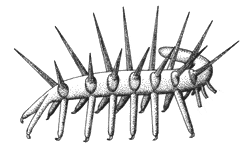 |
Back to 315 Syllabus |
|
Geology 315 INVERTEBRATE PALEONTOLOGY & PALEOECOLOGY Fall 2007 |
|
Four lecture periods will be devoted to short (~10 minute) presentations by students.
Each student will report on an assigned article by emphasizing the major issues covered, describing the
methods used by the author(s) to understand the evolutionary phenomena discussed, and relating the
article to topics covered in class. Students will be responsible for providing xerox copies of a
one-page, typed summary (maximum of 2-3 paragraphs double-spaced beginning with a complete citation
of the article) and 2 key illustrations or diagrams (used as overheads). Grades will be based on
the quality of the summary page and oral presentation and on participation in group discussions.
Seek my guidance well in advance to make sure that you understand the essential aspects of your article.
|
|
|
|
|
 |
Back to 315 Syllabus |
|
http://classes.colgate.edu/csoja/geol315/ |
|